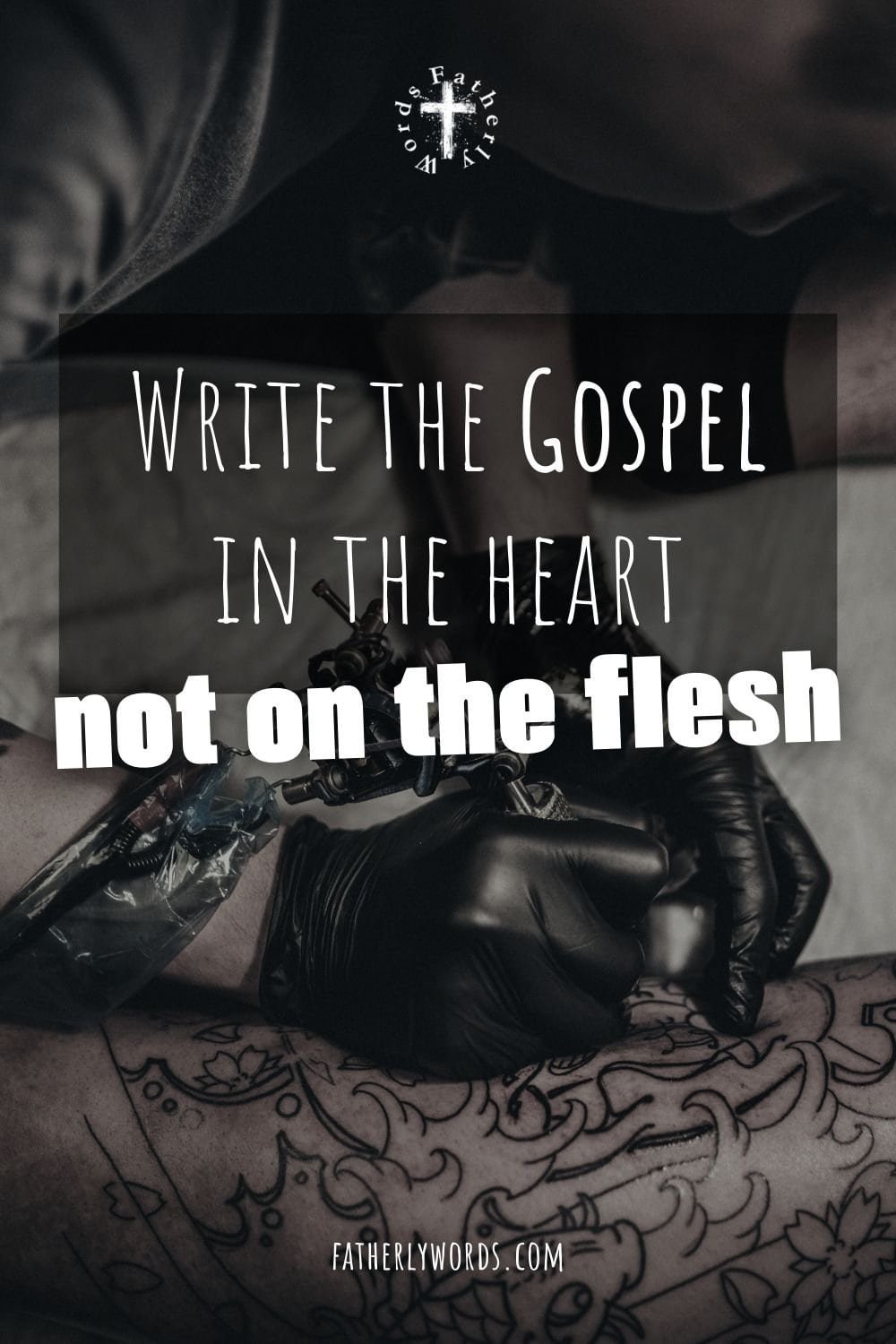Tattoos In Christianity And Orthodoxy
The question of tattoos in Christianity, and especially in Orthodoxy, is not a modern curiosity. It has deep theological meaning because it touches upon the most fundamental truth of our existence: that our body and soul belong not to us but to God.
The Orthodox Church does not see the human body as a canvas for personal expression but as a temple of the Holy Spirit.
The modern world promotes tattoos as art, self-identity, or even empowerment. But Orthodoxy looks deeper.
The Church asks: what does it mean when we alter the body that God created perfect?
Can we, as Christians, mark permanently the body given to us by our Creator?
The answer from Holy Scripture, from the saints, and from Orthodox doctrine is clear: Tattoos are not allowed, even if they are of Christian content.

The Human Body Belongs To God
One of the most powerful errors of modern thought is the belief that “my body is mine and I can do whatever I want with it.”
But the Word of God corrects this illusion. In the Divine Services of the Church we constantly hear the prayer: “O God of spirits and of all flesh.” Both body and soul are His.
Saint Paul reminds us in his epistle:
“Do you not know that your body is the temple of the Holy Spirit within you, which you have from God? You are not your own, for you were bought with a price. Therefore glorify God in your body and in your spirit, which are God’s”
1 Corinthians 6:19–20
The faithful Orthodox Christian does not belong to himself but to Christ who redeemed him. This is why the body cannot be treated as a possession for decoration. It must be offered to God in holiness.
The Old Testament Command Against Tattoos
The prohibition of tattoos is not a modern Church invention. It is given directly in the Law of God.
In Leviticus we read:
“Do not cut your bodies for the dead or put tattoo marks on yourselves. I am the Lord.”
Leviticus 19:28
The Holy Fathers explain that this commandment reveals that God does not allow man to engrave signs, drawings, or words into the flesh.
Tattoos were connected with pagan practices, idol worship, and magical symbols. The same applies today, when countless tattoos use demonic symbols, occult images, or simply the vain search for human self-expression.
Leviticus is the third book of the Old Testament, containing a detailed set of laws, rituals, and moral codes given by God to the Israelites.
The Orthodox Church believes in Leviticus as part of the Holy Scriptures and the inspired Word of God. However, it does not follow the ceremonial and ritual laws (such as animal sacrifices and dietary rules) because they are considered to have been fulfilled by Jesus Christ.
Instead, the book is valued for its moral laws and its spiritual significance in foreshadowing the New Covenant.
Why Tattoos Are Spiritually Dangerous
The Fathers of the Church often emphasize that sin begins with forgetfulness of God. When man forgets who created him, he tries to reinvent himself. Tattoos are part of this rebellion.
Tattooing is a visible mark of apostasy. It prepares the heart to accept the “seal” of the Antichrist, because one who has long accustomed himself to marking the body will more easily accept the future satanic mark. The devil promotes tattoos to weaken the Christian conscience and prepare souls for enslavement.
The Psalmist cries:
“I am fearfully and wonderfully made; marvelous are Your works, and my soul knows it very well”
Psalm 138:14 (LXX)
To mark or deform the body is to deny that God’s creation is wonderful. It is to say: “Your work is not enough, I will improve it.”
Are Christian Tattoos Allowed?
The answer is still no. Tattoos are not compatible with the Christian life. They show disrespect for the temple of the Holy Spirit, they imitate pagan customs, and they contradict the Word of God.
Saint Basil the Great wrote:
“The fashion of painting the body with dyes is the invention of the devil, and whoever wears such things dishonors the Creator.”
The body is not an object for decoration, but a vessel sanctified through baptism, chrismation, and the Holy Eucharist.
Christians are called to carry the mark of the Cross upon their soul, not to engrave worldly images upon their skin.
The devil, however, has learned to disguise sin under holy names.
In our times he tempts people with what they call “Christian tattoos,” perhaps with a Cross, or a verse from Scripture, or even the name of Christ.
But the Orthodox Church teaches that holiness cannot be engraved in ink. The devil knows that if he can persuade us to break God’s commandment under the excuse of devotion, he has already won.
The holy Cross is never meant to be a tattoo. It is meant to be traced with our hand on our forehead and our heart, or worn as a blessed Cross given at baptism.
When people place it on their skin as a tattoo, they mix the holy with the profane. This is a deception. The devil offers a counterfeit piety, where instead of inner repentance and prayer, one is satisfied with an outward mark.

Saint John Chrysostom teaches that the devil always counterfeits the works of God. Just as he presents false prophets and false miracles, he also presents false symbols of faith. A tattoo of a Cross is not the Cross of Christ, because it is made in disobedience.
The true Christian seal is not ink in the flesh but the grace of the Holy Spirit, received in baptism, chrismation, and the life of repentance.
What If Someone Already Has A Tattoo?
The Church never despises or rejects those who already bear tattoos. Repentance is always open. The important thing is to confess, to ask God’s forgiveness, and to live henceforth according to His commandments.
If a tattoo carries demonic or sinful imagery, it is good for the Christian to consider removing it if possible, or at least to sanctify the body by the sign of the Cross and constant prayer.
But the key is not merely removal of ink, but repentance of the spirit. God does not abandon His children.
In any case, you should consult your spiritual father.
What About Fake Tattoos For Children?
Parents sometimes ask whether temporary tattoos for children are acceptable. In truth, even this playful imitation carries risk.
It introduces children to the idea that decorating the body with artificial marks is acceptable.
Orthodoxy teaches children to honor their body as a gift from God.
It is far better to encourage children to wear the Cross, to kiss holy icons, and to decorate their life with prayer rather than their body with drawings.
While temporary tattoos may not be a permanent sin, they do not nurture an Orthodox Christian mindset.
The Apostle says: “Bring them up in the training and admonition of the Lord”
Ephesians 6:4
Teaching respect for the body from the earliest years is part of that training.
The Orthodox Alternative To Tattoos
Instead of writing on the body, the Orthodox Christian writes God’s commandments on the heart.
“I delight to do Your will, O my God, and Your law is within my heart”
Psalm 39:9 (LXX)
The true seal of the Christian is baptism and the Cross.
In baptism we are marked forever as Christ’s own. At every Divine Liturgy we sign ourselves with the Cross, which is the only true “tattoo” of the Orthodox soul, written not in ink but in grace.
Saint Paisios the Athonite said that Christians should not seek external marks but inner holiness: “It is not the sign outside but the humility inside that shows Christ lives in us.“
Differences Between The Modern World And Orthodox Christianity On Tattoos
- The world says: “My body belongs to me.” Orthodoxy says: “My body belongs to God.”
- The world views tattoos as art and self-expression. Orthodoxy views them as disrespect to God’s creation.
- The world associates tattoos with freedom. Orthodoxy sees them as slavery to sin and to the devil.
- The world promotes tattoos as fashion. Orthodoxy calls us to modesty and purity.

- The world normalizes tattoos from childhood. Orthodoxy raises children to respect the holy body given by God.
- The world embraces pagan symbols without fear. Orthodoxy rejects idolatrous and occult marks.
- The world seeks identity in ink. Orthodoxy finds identity in baptism and the Cross.
- The world celebrates outward appearance. Orthodoxy treasures the inner man renewed by grace.
How Parents Can Explain This To Children
Parents should speak to children in very simple words. They can say:
“God made your body, and He made it very good. Your body is like a little church where Jesus lives. We do not draw on the walls of the church, and we do not draw on the body either. Instead, we keep it clean and holy for God.”
They can explain that wearing the Cross and making the sign of the Cross is the way Christians show they belong to Jesus, not by tattoos. Children can understand that God wants them just as He created them.
Conclusion
Tattoos in Christianity and Orthodoxy are not just a question of fashion or culture. They touch the very heart of our faith. The Orthodox Church clearly teaches that tattoos are forbidden:
- because our body belongs to God,
- because Scripture commands it, and
- because they prepare the soul for a world without Christ.
For those who already bear tattoos, the way is repentance, forgiveness, and sanctification.
Dive Deeper: